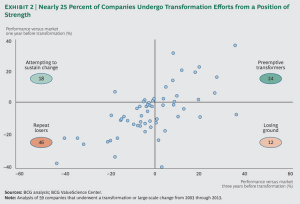Across almost all sectors and regions, companies face unprecedented disruption. The competitive advantages that once gave companies a defensible position—their product lineup, scale, or legacy position—are no longer as secure as they were. Some upstart with a newer and more agile operating model will start taking market share—if it hasn’t already.
In the face of this volatility and complexity, most businesses must transform, meaning a comprehensive change in strategy, operating model, organization, people, and processes. More than ever before, transformation is an imperative. In fact, forward-thinking companies are launching preemptive transformations while they still hold a dominant market position, retooling themselves to stay ahead. The hard reality, however, is that many transformations fail. Some 75 percent fall short of their targets—in terms of value generated, timing, or both.
The Boston Consulting Group, through work with clients in transformation efforts around the world, has developed an approach that flips the odds in a company’s favor. This report is an effort to give transformation leaders the tools and approaches to lead a successful and sustainable transformation effort.
Unprecedented Disruption
Across industries and regions, the need for business transformation is enormous and growing. The competitive environment today is far more unpredictable than it was even a decade ago, with disruption arising from all angles. Digitization and globalization are blurring the lines between sectors as well as between traditional competitor groups. Technology is changing consumer behavior, empowering start-ups, making pricing more transparent, and reducing product life cycles. Today’s “two-speed world,” characterized by rapid growth in emerging economies and slower growth in developed countries, forces companies to develop unique strategies1 for each environment. Additionally, companies must rethink—and continually reassess—their operational footprint, owing to changing costs, evolving demand, and unfolding trade restrictions.
As a result, the traditional sources of competitive advantage—market position, scale, or legacy—are diminishing, and established operating models are becoming obsolete. That leads to greater volatility within industries, creating a churn effect in which the dominant player is increasingly overtaken by more nimble companies with stronger business models.
According to research2 conducted by BCG, the probability that a sector’s market-share leader is also its profitability leader declined from 35 percent in 1950 to just 7 percent in the current environment. During the same period, volatility in earnings before interest and taxes (EBIT) margin increased nearly fivefold. A leading company that misses one market shift loses three to five years in development time, which is enough to cede the leading position. Miss two turns, and your company is in real danger.
An Imperative in Most Companies and Sectors
In a shifting environment, most businesses must transform, meaning a fundamental change in strategy, operating model, organization, people, and processes. For most companies, the urgency is high; for others, it is an ongoing, adaptive process. In both cases, though, the transformation fundamentally alters the trajectory of the company. Equally important, it is not a onetime event but an ongoing process of evolution as market conditions continue to change. Successful transformation normally requires rapid, short-term improvements to the bottom line to establish traction and to position the company to win in the medium term. At the same time, organizations need to build the right team, organization, and culture to achieve sustainable results over the long term. All of these aspects need to happen in parallel.
In the past, a transformation effort was perceived as a radical solution indicating that a company had broad and systemic problems—that is, that it had no choice but to change. That perception is increasingly outdated. In fact, fewer than half of BCG clients that have undergone a transformation effort over the past decade had been chronic underperformers. Indeed, nearly 25 percent of them were consistently ahead of their competitors. Leading companies in the sample chose to undergo preemptive transformations that further reinforced their competitive strengths. (See Exhibit 2.)
Transformation: The Imperative to Change by Lars Faeste, Jim Hemerling, Perry Keenan, and Martin Reeves
More: Five Case Studies of Transformation Excellence in www.bcgperspectives.com
